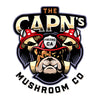
Elm Oyster Mushrooms
Elm Oyster Mushrooms, scentifically known as Hypsizygus ulmarius, are a type of edible mushroom that are often mistaken for true oyster mushrooms (Pleurotus species). Elm oysters are found growing on living hardwood trees, particularly elms and box elders, and sometimes on beech, maple, willow, and oak. Elm Oysters offer a mild, delicate flavor with subtle earthy or nutty undertones. When cooked, they develop a firm, meaty texture, making them a good substitute for meat in various dishes. They are versatile and can be used in a wide range of culinary applications, from stir-fries and risottos to soups and sauces.
Don't know how you're supposed to cook these mushrooms, click here to be redirected to The CAPN's favorite recipes.
Here's a more detailed breakdown:
Mild and Delicate:
Elm oyster mushrooms are not overpowering in flavor, making them a great addition to dishes where you want to enhance other flavors without masking them.
Earthy or Nutty Undertones:
You might detect a subtle hint of earthiness or a mild nutty flavor, which adds complexity to their taste.
Meaty Texture:
When cooked, elm oyster mushrooms develop a firm, almost scallop-like texture, making them a popular choice for vegetarian and vegan dishes that benefit from a meaty component.
Versatile:
Their mild flavor and meaty texture make them suitable for various cooking methods and dishes, including stir-fries, risottos, soups, stews, and sauces.
Health Benefits:
Elm Oyster Mushrooms are a nutritional goldmine. They are rich in vitamins, including the B-complex group, and essential minerals such as iron and potassium. Their high fiber content makes them an excellent choice for digestive health, and they also have properties known to support the immune system.

